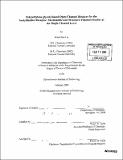| dc.contributor.advisor | Stuart S. Licht. | en_US |
| dc.contributor.author | Lin, Wan-Chen, Ph. D. Massachusetts Institute of Technology | en_US |
| dc.contributor.other | Massachusetts Institute of Technology. Dept. of Chemistry. | en_US |
| dc.date.accessioned | 2009-08-26T17:10:59Z | |
| dc.date.available | 2009-08-26T17:10:59Z | |
| dc.date.copyright | 2009 | en_US |
| dc.date.issued | 2009 | en_US |
| dc.identifier.uri | http://hdl.handle.net/1721.1/46643 | |
| dc.description | Thesis (Ph. D.)--Massachusetts Institute of Technology, Dept. of Chemistry, 2009. | en_US |
| dc.description | Vita. | en_US |
| dc.description | Includes bibliographical references. | en_US |
| dc.description.abstract | Ion channels are essential mediators in nervous signaling pathways. Because hyperactivation of ion channels can lead to pathological disorders such as congenital myasthenic syndromes and neurodegeneration, channel inhibitors are potentially useful in the treatment of channel-associated diseases. Open-channel blockers are channel inhibitors that transiently occupy the open pore of ion channels and impede current flow. They have been used in both clinical treatments of diseases and fundamental researches of synaptic transmission. However, the rational design of open-channel blockers is challenging, mainly due to the paucity of high-resolution structures for the pore regions of ion channels. The work presented in this thesis aims to test an alternative strategy for designing open-channel blockers. The proposed strategy utilizes the flexibility of a polymer backbone, poly(ethylene glycol) (PEG), to maximize blocker-pore interactions. A proof-of-concept study is presented for the muscle-type nicotinic acetylcholine receptor (AChR). Single-channel electrophysiological measurements with a series of PEG-trimethylammonium (PEG-TMA) conjugates show that short bivalent PEG-TMAs containing four to thirteen ethylene oxide units in the backbone block the open AChR in a length-dependent manner. Both the blocking and unblocking rate constants decrease with increasing backbone length. Replacing the TMA moiety with other small quaternary ammonium (QA) groups further enhances the blockade affinity. The ability of a PEG-based blocker to stimulate AChR opening is also sensitive to the QA structure. The PEG-based blockers tested in this thesis interrupt AChR currents with a broad range of kinetics (blocking rate constant: 10-170 [mu]M-1s-1; unblocking rate constant: 2-35000 s-1) and pore affinities (equilibrium dissociation constant: 0.1-850 [mu]M). The blocking rate constants of the PEG-based blockers are consistent with those of previously reported open-channel blockers for the AChR. The fastest and slowest unblocking rate constants of the tested molecules are similar to that of acetylcholine and (+)-tubocurarine, respectively. The results from this pilot study provide useful insights into the future design of kinetically tunable open-channel blockers. | en_US |
| dc.description.statementofresponsibility | by Wan-Chen Lin. | en_US |
| dc.format.extent | 186 p. | en_US |
| dc.language.iso | eng | en_US |
| dc.publisher | Massachusetts Institute of Technology | en_US |
| dc.rights | M.I.T. theses are protected by
copyright. They may be viewed from this source for any purpose, but
reproduction or distribution in any format is prohibited without written
permission. See provided URL for inquiries about permission. | en_US |
| dc.rights.uri | http://dspace.mit.edu/handle/1721.1/7582 | en_US |
| dc.subject | Chemistry. | en_US |
| dc.title | Poly(ethylene glycol)-based open-channel blockers for the acetylcholine receptor : mechanistic and structure-function studies at the single-channel level | en_US |
| dc.type | Thesis | en_US |
| dc.description.degree | Ph.D. | en_US |
| dc.contributor.department | Massachusetts Institute of Technology. Department of Chemistry | |
| dc.identifier.oclc | 426513588 | en_US |
